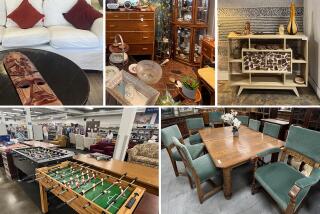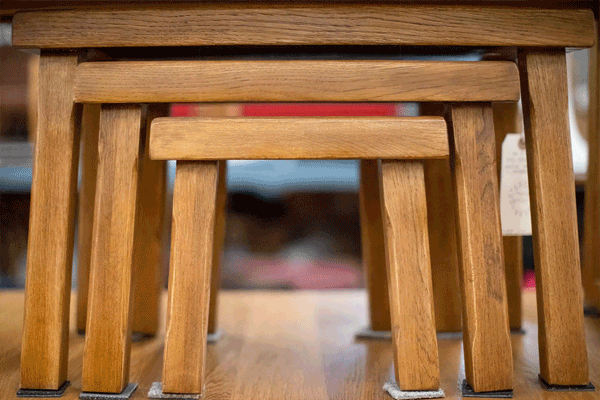This Expert Will Know Whether or Not It’s Faux
- Share via
George E. Read has spent his life in the antiques world. Educated at Harvard University, he studied in Europe for years, then joined Sotheby’s International, where he directed the English furniture department for 13 years and presided over many sales as an auctioneer.
Now with his own international arts management group based in Charleston, S.C., he is exploring the Internet as the latest source for antiques information (https://www.georgeread.com).
In town to speak at the Capistrano Antiques and Garden Show in San Juan Capistrano and to give seminars in Los Angeles, Read does his best to demythologize antiques.
Question: How can you tell if someone is really an antiques expert?
Answer: The people who are really good at this are generally the most humbled by it all. There is this mountain of information in each field that you don’t know and that you’ll never know.
Probably “doubt” is a form of truth. When you run into people who know what they’re doing, they’re never all that sure. It’s the people with the puffed-up snobbery who act as if they know for sure who don’t.
Q: What is the best way to look at an antique?
A: The information you need is invariably right there in front of you. It doesn’t require going to museums or reading books. It’s feet-on-the-ground logic that makes a great antique expert. That’s easy to say but hard to do. Still, if you look long enough, you can learn how to draw the information out of the object.
Q: How do you value an antique?
A: Valuing an object is not hard. That you can learn. It’s no harder than learning the price of eggs or butter. The hard thing is to know if it’s real or not. That takes real talent, because there are people out there making great imitations.
Q: What is an example of spotting a fake?
A: Say you’re considering a chest of drawers. Look at the way the drawers have worn down. Obviously the right-hand top drawer will be worn down more than the bottom left-hand drawer. If all the drawers seem to be worn the same amount, it’s a fake. That’s just logic.
Q: What area has the most fakes right now?
A: French and English country furniture. This is because they’re not terribly expensive. For example, if you were a counterfeiter, you’d probably make 20s because they’re worth more than ones and fives, but people won’t check them as closely as 50s and hundreds. So fake furniture is in the $400 to the $2,000 or middle range. They’re made from old pieces of wood, and they’re coming over by the boatload.
Q: Is there a way to look at something and determine whether it’s a great piece or not?
A: That’s hard to do. The more expensive the thing, the easier it is to know it’s great. The hard thing to do is go into an under-$1,000 sale and find great objects.
I have a friend who can find things in the crummiest junk sale, because she’s trained herself to look at things as if she’s never seen them. I look at something and say, “OK. It’s cloisonne, 1850, French, etc.” All this stuff is going through my mind, but what I’m not doing is actually looking at the thing.
Q: Is there such a thing as trends in antiques?
A: Things do tend to come and go. Some antiques endure better than others do. Rococo goes but always comes back. German Biedermeier furniture is an example of a style that was overdone. An eclectic mix of periods and styles of antiques in a room is really the biggest trend I see right now.
Q: Why do you think this eclectic collecting is so popular?
A: It used to be that if you made a lot of money quickly, you collected French furniture because you thought they were real antiques. As time went on and you didn’t need to show off so much, you got rid of some of the French antiques and bought comfortable English ones. At the end of the day, you ended up with a mixture. Nowadays people are smart and are doing that at the beginning.
Q: What is your advice to a would-be collector?
A: First, buy something. It doesn’t matter what it is, but commit yourself by putting your money down. That forces you to make a lot of decisions. You’ll gain because you’ll discover what you like and what you don’t like. You can’t look at something, walk away and really know it.
The second thing is to not feel dumb. You’re bringing to the game what you know, and you’ll get better as you go along. Remember that it’s just “stuff,” and it should never take over your life.
Q: Are there any antiques out there that are undervalued?
A: Yes. American regional furniture, except that from New England, is underpriced. There’s a reason for that. Furniture from New England has been very well researched, so it’s very expensive. In the rest of the country, people don’t know about furniture makers in Santa Fe or Mississippi or California or Texas. The research is going on, and the books are starting to come out. When they’re all out, the prices will rise quickly.
Q: Any final piece of advice?
A: Keep your eyes open and bring the same kind of logic to buying antiques that you use in your daily life. Antique buying shouldn’t daunt you.


